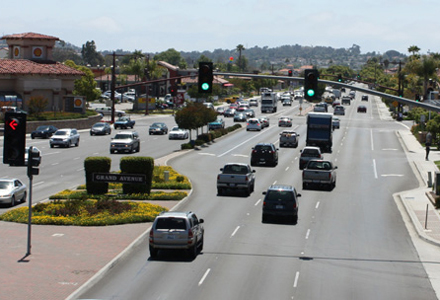Alicia Parkway corridor, located in Orange County, California, was part of Phase 1 of an inter-jurisdictional Traffic Light Synchronisation Programme (TLSP) in Orange County designed to increase mobility and overall drive quality while reducing fuel consumption and greenhouse gas emissions.
By increasing average speeds and reducing travel times via the reduction in stops, the programme sought to reduce vehicle acceleration and deceleration events along the corridor; these have been identified as the leadin

Alicia Parkway corridor, located in Orange County, California, was part of Phase 1 of an inter-jurisdictional Traffic Light Synchronisation Programme (TLSP) in Orange County designed to increase mobility and overall drive quality while reducing fuel consumption and greenhouse gas emissions.
By increasing average speeds and reducing travel times via the reduction in stops, the programme sought to reduce vehicle acceleration and deceleration events along the corridor; these have been identified as the leading cause in greenhouse gas production.The TLSP was funded through the Proposition 1B -Transportation Bond Program (Prop 1B) and for Alicia Parkway addresses the corridor's east-west segments on either side of Interstate 5 (I-5) - the main north-south freeway. During the weekday Alicia Parkway, a freeway-centric corridor, has traffic volumes in excess of 60,000 vehicles per day on its short spans near the I-5 freeway. After installing two
Project:
Alicia Parkway traffic light synchronisation: 11-mile corridor with 41 signalised intersections
Benefits:
• 1.1 million gallon fuel savings over three years
• 11% reduction in overall travel times
• Up to 75% reduction in number of stops
• 7% reduction in greenhouse gases
• Average commute speed increased by as much as 31%
Project outline
In April 2008, as part of Prop 1B and matching funds from Measure M (M1),Improvements for the Alicia Parkway TLSP included upgrades to traffic management systems, intersection traffic signal controllers, communication systems, and new optimised signal timing. For this ITS upgrade, two Econolite Centracs systems were installed - a physical installation in Laguna Hills, and a virtual installation in Mission Viejo. Additionally, several ASC/3 traffic controllers were installed, enabling immediate traffic signal coordination along the two major segments of Alicia Parkway: the west segment from Crown Valley Parkway to I-5, which includes 24 signalised intersections; and the east segment from Santa Margarita Parkway to I-5, which includes 17 signalised intersections.
A powerful ATMS was required as a turnkey solution that enabled enhanced system-wide control of signal controllers, operational monitoring, inter-agency sharing, system scalability and support. A powerful client-server ATMS application that provided seamless wide-area network communications using current workstations and IT tools, including the capability to communicate over both Ethernet fibre-optic and existing copper serial systems, was a prerequisite.
The ATMS also had to provide the system and support flexibility essential to stay within budget. In addition, it had to be configured in a virtual server environment to integrate with an existing IT system, as well as integration requirements of a new gigabyte fibre-optic Ethernet communications system.
Results
Before and after travel time studies were conducted on the two corridor segments for morning, midday, and evening periods during the weekdays for westbound and eastbound directions. Addressing the project objectives, the metrics compared for the study were travel time in minutes, number of stops, average speed and greenhouse gas production. In some instances, the number of stops reduced by 75 per cent during the morning and evening hours. Average speed increased by as much as 31 per cent. In addition, greenhouse gas emissions were reduced by 7 per cent.Interestingly, the study validated the significance of dynamically monitoring signal timing and operations. As anticipated, there were several categories that showed little to no improvement, particularly in travel times and number of stops during the morning and evening commute through the Laguna Niguel, Aliso Viejo and Laguna Hills city segments. These three cities had previously deployed traffic signal synchronisation, using Econolite systems to optimise traffic flow. The synchronisation strategies and Econolite solutions were installed and proactively monitored by traffic engineering firm, Hartzog & Crabill under contract by these cities.










